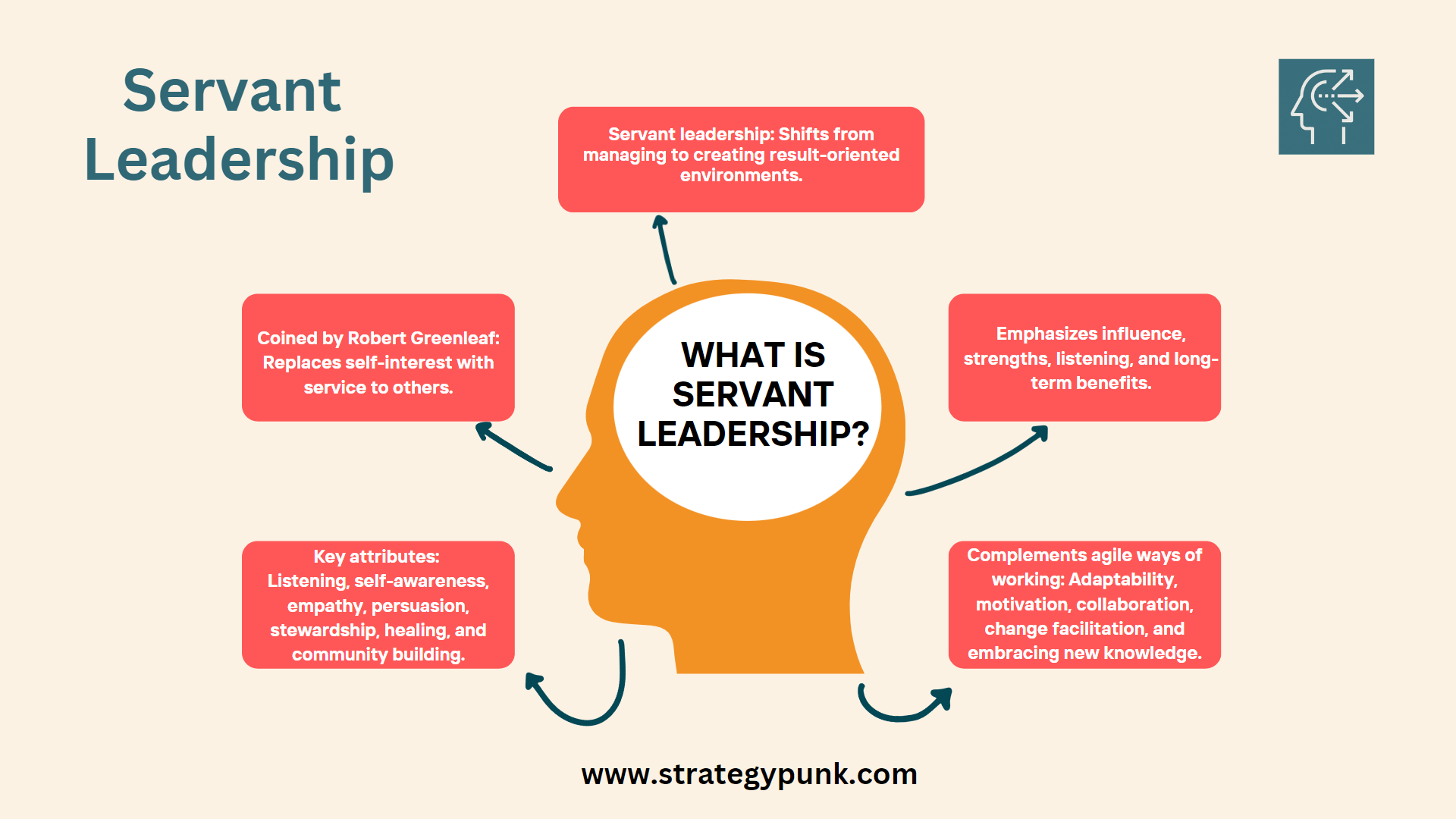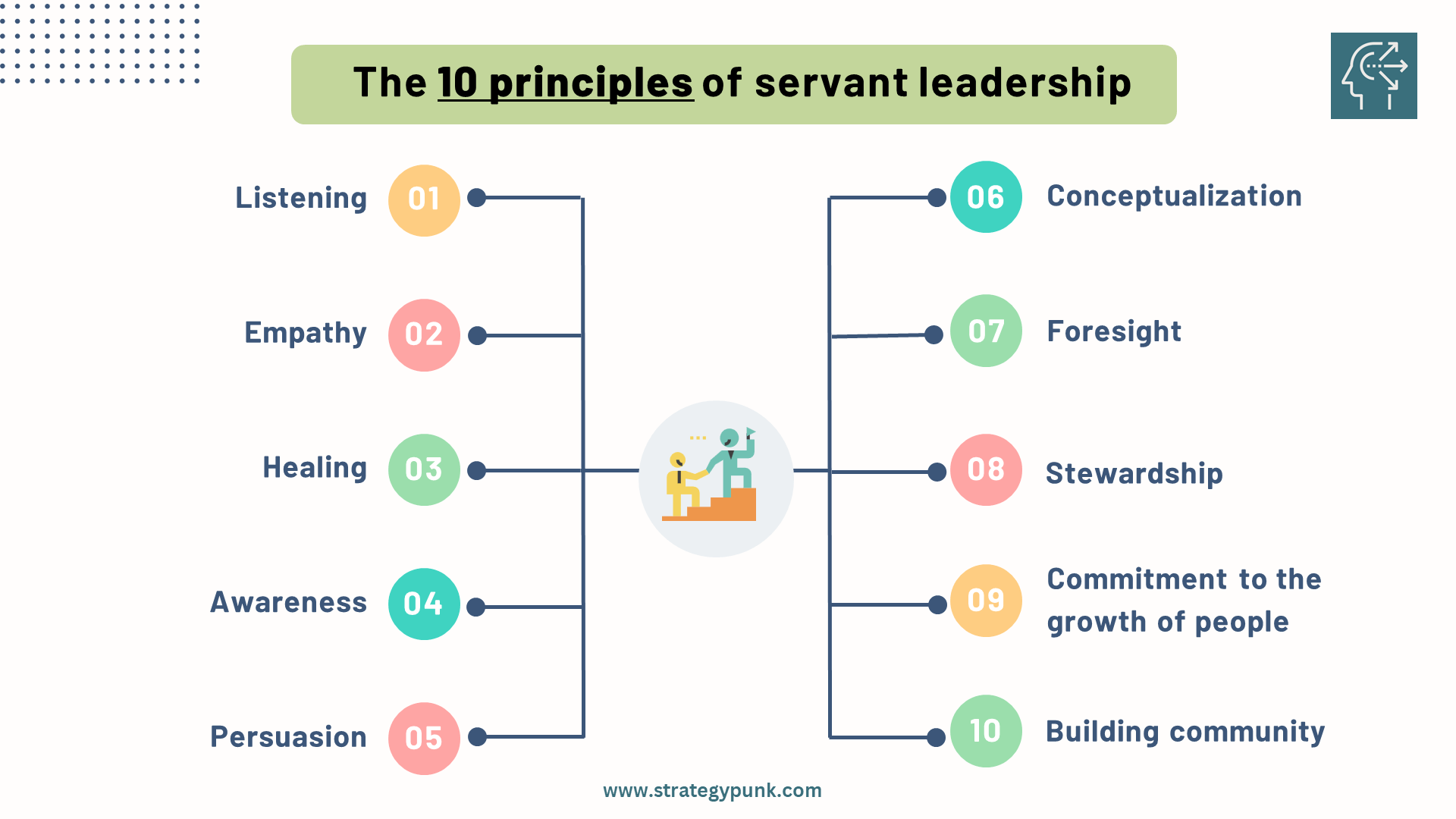Servant Leadership: The Selfless Way to Lead Your Team
Dive into Servant Leadership's philosophy, transformative benefits, and successful application in top companies like Starbucks.

Introduction
Servant leadership is a leadership approach that has gained significant popularity in recent years. It is a style that puts serving others above all other priorities. Rather than managing for results, a servant leader focuses on creating an environment where their team can thrive and accomplish their highest-impact work. This approach is based on the idea that leaders who serve their teams first can achieve better results in the long run.
At its core, servant leadership prioritizes employees' growth, well-being, and empowerment. It aims to foster an inclusive environment that enables everyone in the organization to thrive. The theory is that instead of employees serving the leader, the leader serves the employees. Servant leaders seek to help the people they serve grow as individuals. If they are growing, then they desire to perform and achieve.
In this article, we will explore the concept of servant leadership in detail. We will discuss the principles and benefits of this leadership approach and provide examples of how it can be applied in practice. Whether you are a leader looking to adopt a new leadership style or an employee interested in understanding how servant leadership can benefit your organization, this article will provide valuable insights.
What is Servant Leadership?
Servant leadership is a philosophy and leadership style that prioritizes the growth, well-being, and empowerment of employees and other organizational stakeholders. Rather than managing for results, a servant leader focuses on creating an environment where their team can thrive and accomplish their highest-impact work.
Servant Leadership Characteristics
Several vital traits characterize servant leadership, including empathy, listening, stewardship, and commitment to personal growth. Servant leaders seek to understand their employees' needs and perspectives, and they prioritize their development and well-being over their own goals and ambitions.
The Servant as Leader
Robert K. Greenleaf, who founded the Robert K. Greenleaf Center for Servant Leadership, first introduced the concept of the servant as a leader. Greenleaf believed that the most influential leaders see themselves as servants first and prioritize their followers' needs over their interests.
Servant Leadership Theory
Servant leadership theory is based on the idea that leaders should serve their followers rather than vice versa. This approach contrasts more authoritarian leadership styles, such as autocratic or directive leadership, prioritizing control and obedience over collaboration and empowerment.
Leadership Model
Servant leadership is a model for effective leadership in various settings, including business, education, and religious organizations. The model emphasizes the importance of building strong relationships with followers, empowering them to take ownership of their work, and creating a culture of trust and collaboration.
Servant leadership is a powerful and practical approach to leadership that prioritizes the growth and well-being of employees and other stakeholders. By focusing on the needs of others rather than their own goals and ambitions, servant leaders can create a culture of trust, collaboration, and empowerment that leads to tremendous success and fulfillment for everyone involved.
The Importance of Servant Leadership
Servant leadership is a philosophy that prioritizes employees' growth, well-being, and empowerment. It fosters an inclusive environment that enables everyone in the organization to thrive. Here are some key reasons why servant leadership is so important.
Growth and Development Opportunities
One of the main benefits of servant leadership is that it provides growth and development opportunities for team members. Servant leaders are committed to their people's growth and actively seek opportunities for their team members to learn and develop new skills. This approach benefits not only the individuals on the team but also the organization as a whole, as it helps to build a more skilled and capable workforce.
Commitment to the Growth of People
Servant leaders are committed to people's growth and prioritize their team members' well-being and development. They do this by providing mentorship, coaching, and support and creating an environment that fosters personal and professional growth.
Building Community
Servant leaders understand the importance of building community within their organization. They create an environment where team members feel valued, respected, and supported, and everyone works toward a common goal.
Collaboration and Teamwork
Servant leaders prioritize collaboration and teamwork and understand that the best outcomes are often achieved when people work together. They create an environment where team members are encouraged to share ideas and solve problems together.
Trust and Empathy
Servant leaders build trust with their team members by demonstrating empathy and understanding. They take the time to listen to their team members and understand their perspectives, and they build relationships based on mutual respect and trust.
Awareness and Listening
Servant leaders know what is happening within their organization and actively listen to their team members' feedback. They use this feedback to make informed decisions and create an environment that supports their team's needs.
Servant leadership is a vital philosophy prioritizes employee growth, well-being, and empowerment. It fosters an inclusive environment that enables everyone in the organization to thrive, and it is a powerful tool for building strong, collaborative teams that can achieve great things.
Successful Servant Leadership Practices
Servant leadership is a leadership approach that emphasizes serving others above all other priorities. Successful servant leaders focus on creating an environment where their team can thrive and accomplish their highest-impact work. Here are some practices that successful servant leaders use to create a healthy work environment and lead their teams to success.
Leading by Example
One critical practice of successful servant leaders is leading by example. They model the behaviors they want their team members to exhibit. They set the tone for the team by demonstrating integrity, influence, wisdom, and competence. By showing humility and putting the needs of others first, they earn the trust and respect of their team members.
Innovative and Visionary Strategies
Successful servant leaders are innovative and visionary. They are always looking for ways to improve the customer experience, increase customer satisfaction, and create a positive impact on stakeholders. They are not afraid to take risks and try new things. They encourage their team members to think outside the box and come up with creative solutions to problems.
Encouragement and Motivation
Servant leaders understand the importance of encouragement and motivation in creating a high-performing team. They provide positive feedback and recognition for a job well done. They also motivate their team members to reach their full potential by setting high expectations and providing the support and resources they need to succeed.
Coaching and Problem-Solving
Successful servant leaders coach their team members to help them develop their skills and reach their full potential. They provide constructive feedback and support team members in identifying areas for improvement. They also help team members solve problems by asking questions and guiding them to find solutions independently.
Performance Management and Accountability
Servant leaders hold themselves and their team members accountable for their performance. They set clear expectations and provide regular feedback on progress. They also help team members identify areas for improvement and work with them to develop a plan to address them.
In conclusion, successful servant leaders use a variety of practices to create a healthy work environment and lead their teams to success. Servant leaders can make a high-performing team focused on serving others and achieving their goals through leading by example, innovative and visionary strategies, encouragement and motivation, coaching and problem-solving, and performance management and accountability.
Notable Examples of Servant Leadership
Robert K. Greenleaf
Robert K. Greenleaf is widely regarded as the father of servant leadership. He was a business executive and author who coined the term "servant-leader" in his essay "The Servant as Leader" in 1970. Greenleaf believed that the primary role of a leader is to serve others rather than to accumulate power and wealth for themselves. He emphasized the importance of empathy, listening, and foresight in leadership. Greenleaf's ideas have influenced many leaders and organizations around the world.
Hermann Hesse's Journey to the East
Hermann Hesse's novel "Journey to the East" is a classic example of servant leadership. The story follows a group of travelers on a spiritual journey led by a servant named Leo. Leo is humble, compassionate, and dedicated to serving the group's needs. He is not interested in personal power or glory but in helping others achieve their goals. Leo's leadership style inspires the group to work together and overcome challenges.
Larry C. Spears
Larry C. Spears is the former CEO of the Robert K. Greenleaf Center for Servant Leadership. He has written extensively on servant leadership and has worked with many organizations to implement its principles. Spears identifies ten characteristics of servant leaders, including listening, empathy, healing, and persuasion. He believes servant leadership is a powerful tool for creating positive change in the world.
Companies Practicing Servant Leadership
Many companies have adopted the principles of servant leadership in their operations. Starbucks, for example, has a mission statement that emphasizes its commitment to serving its customers, employees, and communities. Southwest Airlines is another company that has embraced servant leadership. Its founder, Herb Kelleher, believed that happy employees lead to satisfied customers, and he created a culture that prioritized employee well-being. AT&T is another company that has implemented servant leadership practices, focusing on employee development and community engagement.
In summary, servant leadership is a leadership style that emphasizes service to others rather than personal power or wealth. It has been practiced by many notable leaders throughout history, including Robert K. Greenleaf, Hermann Hesse's Leo, and Larry C. Spears. Many companies, including Starbucks, Southwest Airlines, and AT&T, have adopted servant leadership principles.
Servant Leadership Guide and PDF Template
🎉 We have an additional blog post that's a must-read!
📚 It's a comprehensive guide to Servant Leadership 🙌📈, filled with in-depth insights and actionable tips.
As a bonus, you'll find a free PDF template for immediate download! 📝
Check it out now! 👀🔗👇








